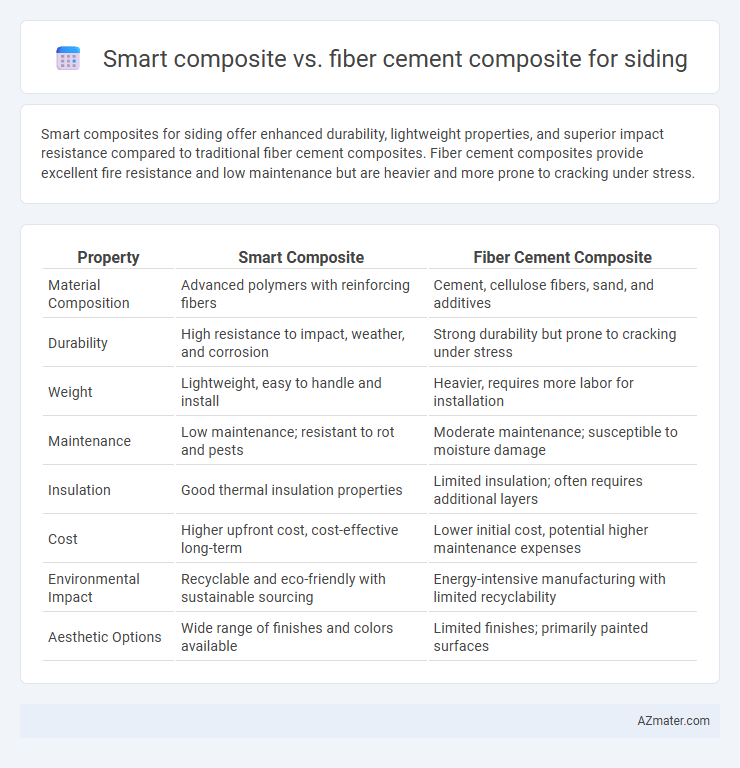Smart composites for siding offer enhanced durability, lightweight properties, and superior impact resistance compared to traditional fiber cement composites. Fiber cement composites provide excellent fire resistance and low maintenance but are heavier and more prone to cracking under stress.
Table of Comparison
| Property | Smart Composite | Fiber Cement Composite |
|---|---|---|
| Material Composition | Advanced polymers with reinforcing fibers | Cement, cellulose fibers, sand, and additives |
| Durability | High resistance to impact, weather, and corrosion | Strong durability but prone to cracking under stress |
| Weight | Lightweight, easy to handle and install | Heavier, requires more labor for installation |
| Maintenance | Low maintenance; resistant to rot and pests | Moderate maintenance; susceptible to moisture damage |
| Insulation | Good thermal insulation properties | Limited insulation; often requires additional layers |
| Cost | Higher upfront cost, cost-effective long-term | Lower initial cost, potential higher maintenance expenses |
| Environmental Impact | Recyclable and eco-friendly with sustainable sourcing | Energy-intensive manufacturing with limited recyclability |
| Aesthetic Options | Wide range of finishes and colors available | Limited finishes; primarily painted surfaces |
Introduction to Siding Materials
Smart composite siding integrates advanced polymers with reinforcing fibers, delivering superior durability, moisture resistance, and energy efficiency compared to traditional materials. Fiber cement composite siding consists of cement, sand, and cellulose fibers, offering excellent fire resistance, low maintenance, and a natural wood-like appearance. Both materials address common siding challenges, but smart composites provide enhanced adaptability in extreme weather conditions and longer lifespan.
Overview of Smart Composite Siding
Smart composite siding integrates advanced materials such as polymers and reinforced fibers, offering superior durability, moisture resistance, and thermal insulation compared to traditional fiber cement composites. Engineered for ease of installation, smart composite siding also provides enhanced impact resistance and low maintenance requirements, making it a cost-effective solution for long-term exterior cladding. The innovative design leverages cutting-edge technology to deliver improved weather performance and aesthetic versatility, positioning it as a modern alternative in residential and commercial siding applications.
Overview of Fiber Cement Composite Siding
Fiber cement composite siding offers exceptional durability and resistance to fire, moisture, and insects, making it a popular choice in both residential and commercial construction. Composed primarily of cement, sand, and cellulose fibers, fiber cement siding mimics the appearance of wood, stucco, or masonry while providing superior weather resistance and minimal maintenance requirements. With its long lifespan and versatility, fiber cement composite siding enhances curb appeal and structural integrity, outperforming many traditional siding materials in longevity and performance.
Material Composition and Technology
Smart composite siding integrates advanced polymer matrices reinforced with nano-fillers, enhancing durability, flexibility, and resistance to moisture and impact compared to traditional fiber cement composites. Fiber cement composite consists predominantly of cement, silica, and cellulose fibers, offering high fire resistance and structural stability but often lacking the adaptive technological enhancements found in smart composites. The manufacturing technology for smart composites employs precise nano-engineering and automated layering processes, resulting in superior performance and lighter weight, whereas fiber cement siding relies on conventional mixing and curing techniques that emphasize strength and longevity.
Durability and Lifespan Comparison
Smart composite siding offers superior durability with enhanced resistance to impact, moisture, and UV degradation compared to fiber cement composite siding, which is prone to cracking and erosion over time. Fiber cement composite siding typically has a lifespan of 30 to 50 years, while smart composites can exceed 50 years due to their advanced material properties and engineered reinforcement. Both materials require minimal maintenance, but smart composites demonstrate better long-term performance in harsh weather conditions and resist fungal growth more effectively than fiber cement.
Weather and Moisture Resistance
Smart composite siding offers superior weather and moisture resistance due to its advanced polymer matrix that prevents water absorption and resists UV degradation, extending the material's lifespan in harsh climates. Fiber cement composite, composed of cement, sand, and cellulose fibers, provides excellent durability and fire resistance but is more prone to moisture absorption, leading to potential swelling and cracking over time if not properly sealed. Selecting smart composite siding ensures enhanced protection against mold, rot, and weather-induced damage, making it ideal for regions with high humidity and frequent rainfall.
Aesthetic Options and Design Flexibility
Smart composites for siding offer a wide range of aesthetic options with customizable textures and colors that mimic natural materials, enhancing architectural appeal. Fiber cement composites provide durable design flexibility, allowing for various profiles, finishes, and paintability that withstand weathering while maintaining visual appeal. Both materials support modern design trends but smart composites often enable more intricate patterns and lightweight installation without compromising durability.
Installation Process and Requirements
Smart composites for siding offer faster installation with lightweight panels that reduce labor time and require fewer structural supports compared to fiber cement composites. Fiber cement siding demands specialized tools, longer curing times, and heavier handling, which increases installation complexity and labor costs. Both materials require careful surface preparation and weatherproofing, but smart composites often provide easier cutting and fastening options, enhancing overall efficiency in the installation process.
Environmental Impact and Sustainability
Smart composite siding offers enhanced environmental benefits due to its use of recycled materials and lower energy consumption during manufacturing, resulting in reduced carbon emissions. Fiber cement composite, while durable and resistant to pests and fire, relies heavily on cement, which has a high carbon footprint and energy-intensive production process. Choosing smart composite siding supports sustainability goals by minimizing ecological impact and promoting resource efficiency in building applications.
Cost Analysis and Long-Term Value
Smart composite siding typically offers higher upfront costs compared to fiber cement composite but delivers superior durability and lower maintenance expenses over time. Fiber cement composite provides a more affordable initial investment while still providing strong resistance to weather and fire, though it may require more frequent upkeep. Evaluating total cost of ownership, smart composites tend to yield better long-term value through extended lifespan and reduced repair needs.

Infographic: Smart composite vs Fiber cement composite for Siding
 azmater.com
azmater.com